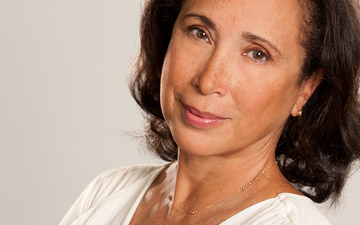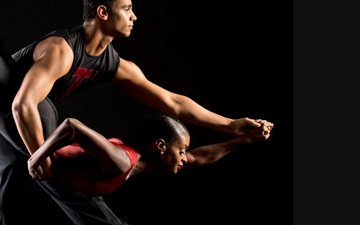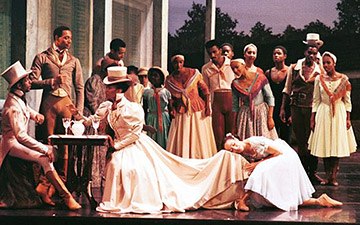
© Matthew Murphy. (Click image for larger version)
Dance Theatre of Harlem
Agon, Swan Lake Act II Pas de Deux, Far But Close, Return
New York, Rose Theater
11 April 2013
www.dancetheatreofharlem.org
Rose Theater page
Black Swans
What is the place of a predominantly black American ballet company today, in our supposedly “post-racial” America? We have a black president and a black ambassador to the United Nations, and yet, if one looks at most of our ballet companies, there is nary a black dancer to be seen. (The situation in modern and contemporary dance companies is less extreme.) As Virginia Johnson, the artistic director of the newly reconstituted Dance Theatre of Harlem, pointed out in a recent New York Times profile, it’s not that ballet companies don’t want black dancers. The problem is more frustrating than simple racism: African American kids are not being introduced to ballet at an early enough age to get a toehold in the field. To succeed in ballet, you have to start early and commit at a young age. In the US, it’s very much a middle, and upper-middle class vocation: parents have to have the means to pony up for shoes, tights, class, tutus, transportation, competition entry-fees and distant ballet academies, all in order to train for a profession that is fleeting at best and often leads nowhere. How many kids who study ballet, even seriously, actually end up joining a company? Then there are the exceptions. Take Misty Copeland, the first black soloist at ABT in years. She didn’t begin lessons at the age of five after being taken to see a performance of The Nutcracker, like so many lucky little girls. She was first exposed to ballet at thirteen (rather late) at her local Boys and Girls Club. For most dancers that would have been too late. The truth is access to ballet training is not equal. Then there is the larger question of the role of such “high” art – and ballet is certainly one of the most rarefied of art forms – in the larger landscape of our culture. Is it relevant? And if so, what does it have to say about our lives?
These are all big questions, and of course it’s unfair to judge the revival of Dance Theatre of Harlem – back after a hiatus of almost a decade – by its ability to answer them in one very short New York season (April 10-14 at the Rose Theater). It’s enough, in a way, just that it is alive. In 2004, the company folded because of money troubles. Now, with a much slimmer roster (eighteen dancers, down from forty-four) and a tight grip on the purse-strings, it has taken its first gingerly steps back onto the stage. Virginia Johnson has had to locate, hire and train a completely new generation of dancers and make them look like a company. Not all of them are black, but, as she recently told Gia Kourlas of the Times, “the African-American culture is a vein that runs through the organization and we don’t want that to disappear.” And, based on the program I saw on April 11th, she has succeeded in this respect. Despite occasional wobbles, hints of nerves and imperfections, the company has a real unity of purpose, and warmth, and life bubbling beneath the surface. The performance I saw was full of promise. Several of the women, like Ashley Murphy, Chyrstyn Fentroy, Gabrielle Salvatto and the prodigiously talented (and young) Michaela DePrince, would grace any ballet company in the country.
There were some real high points. The pas de deux from Balanchine’s Agon, danced by a very young-looking Gabrielle Salvatto and Frederick Davis, was one of the most engaging and sensual interpretations I’ve seen of this duet. Yes, Salvatto was a little wild, perhaps not fully controlled, but such subtleties will come with time. But the most important element was there: heat, understanding, life. There was nothing polite or timid about these dancers’ illustration of Balanchine’s sexual dynamics, the way the woman pushes the man’s arms together as he kneels before her and folds over him like bird of prey, demanding total submission. This was a conversation between a man and a woman, a complex negotiation for the upper hand, aided and abetted by Stravinsky’s acidic, prickly violin and mandolin. All through Agon, the dancers pushed Balanchine’s jazzy, jagged esthetic to the extreme, launching and bending their bodies into his prickly combinations. Was it always elegant? Not always. But it wasn’t timid.
Agon, a ballet closely identified with Arthur Mitchell, the founder of DTH, was the most difficult ballet of the evening, and it showed. The opening and closing sections were not sharp or crisp enough, the complicated counts not quite clear. This was in part the unfortunate result of performing to recorded music (all the music was taped, save for one piece, Far But Close). In the case of both Agon and the Black Swan pas de deux, the recordings were poorly chosen. The Agon tape was clearly not meant to be danced to; Stravinsky’s pointed rhythms were played with little emphasis, which left the dancers grasping for their counts. Without those rhythmic underpinnings, the choreography at times looked disjointed, almost willfully so. The Swan Lake recording was much worse: blaringly loud, horrendously slow, lacking in any dance impulse. The dancers were left to struggle against the tide to create an arc or define a phrase. They did their best under the circumstances. Chyrstyn Fentroy, a very young, ebullient dancer, didn’t take things too seriously, or play up the evil character of Odile with the almost campy glee that is becoming increasingly commonplace. Her dancing was very direct, free of mannerisms; her fouetté turns were strong, despite a little near-tumble at the end. Her partner Da’Von Doane, was not as confident; he struggled a bit through his variation, partially because of the impossibly labored tempo. The men, in general, lacked the polish of the women, though a few, like Jehbreal Jackson, stood out.

© Rachel Neville. (Click image for larger version)
The second half of the program consisted of two newer works, one by Robert Garland (a former member of DTH) and the other by John Alleyne, a Barbadian who grew up in Canada and danced with the Stuttgart Ballet. Neither Far But Close, Alleyne’s piece, nor Return really stood out for its choreography; each embraced a different aspect of the African American experience, something Johnson is clearly trying to grapple with as part of the company’s mission. When Arthur Mitchell founded the company, in 1969, the idea of a troupe of black dancers dancing Agon was empowering enough, but times have changed. Again we return to the question: what should the company’s repertoire be? Far But Close, set to an electronically-enhanced piano trio by Daniel Bernard Roumain, with text by Daniel Beaty, is a kind of socially-engaged high-concept piece that attempts to tell the story of two young, urban black people negotiating their way toward love. Two actors (Daniel Beaty and Nicole Lewis) recite the stilted poetry (“as we lay here in between the sheets – beat, beat – fearful child – beat beat – I believe in love again”); the trio plays behind a scrim on a raised platform. Four dancers noodle across the stage in the deconstructed post-Forsythe vocabulary that has become a kind of calling card for so many contemporary choreographers. Slides across the stage, undulating pelvises, partners spun in awkward poses, high kicks, rolled shoulders, sinuous, snaking arms. The stylishly sexy, relentless movement phrases reflect neither the music nor the text. (As the curtain goes down, the dance continues.) Garland’s Return, on the other hand, is a crowd-pleasing crossover ballet in which the dancers shimmy and shake their hips, throwing in some leaps and spins here and there, to a selection of R&B hits. It’s sexy and fun and light, and the dancers look great, but is this really what they trained for years and years to do? One wonders.
Johnson has a challenge on her hands. So much potential and so much talent; but what is the mission? Certainly, just giving these dancers the opportunity to dance is already a big step. Bringing new talent to the table. Trying out new things. Celebrating the technique of ballet – performed on pointe – as an inclusive art. The ballet world needs these dancers. The feeling in the house was good, despite too many empty seats. Hopefully they’ll fill up soon.

















You must be logged in to post a comment.